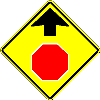Global Navigation

Main Navigation
Sub-Navigation

Content
On a gravel surface, the roadway is not as smooth and the traction is not as powerful. The likelihood of encountering the gyroscopic effect is less, so a skilled rider will gradually reduce pressure on the rear brake and allow the back wheel to begin slowly turning again. Throughout the experience, the rider will keep looking well ahead to ensure the front end remains straight and the bike stays upright.
Occasionally a rider will unintentionally grab a fistful of front brake, calling for the extra traction available on the front tire from the weight transfer before that transfer occurs. This can cause the front wheel to lock and skid. Because this is the wheel that guides and "steers" our motorcycle, we have to respond quickly. . We must regain traction on the front tire in order to control our bike. Immediately release the front brake and reapply it. This is why squeezing the front brake is so important. The squeezing action slows our use of the front brake just enough to allow the weight transfer to occur giving us the extra traction we seek.
Other Challenges
Braking on steep hills can alter the effects we are used to experiencing. Gravity may reduce the amount of weight transfer when we are going uphill giving us more than normal traction on the rear tire and less on the front. Likewise, gravity may assist the weight transfer when going downhill over lightening the rear tire and making it easier to lock the back wheel.
A question often asked about braking involves using the engine to slow, especially for stop signs. Doesn't running down through the gears seem to be an effective way to gradually slow our bike as we approach a controlled intersection? While this technique may mechanically slow our ride, there are two things to consider about this practice.
Sidebar
Footer
Copyright 1996-2015 Chuck Miles All Rights Reserved
All information on this site, including all articles, are copyrighted materials belonging to Chuck Miles.
Design: Made in Austria | Author: G. Wolfgang



